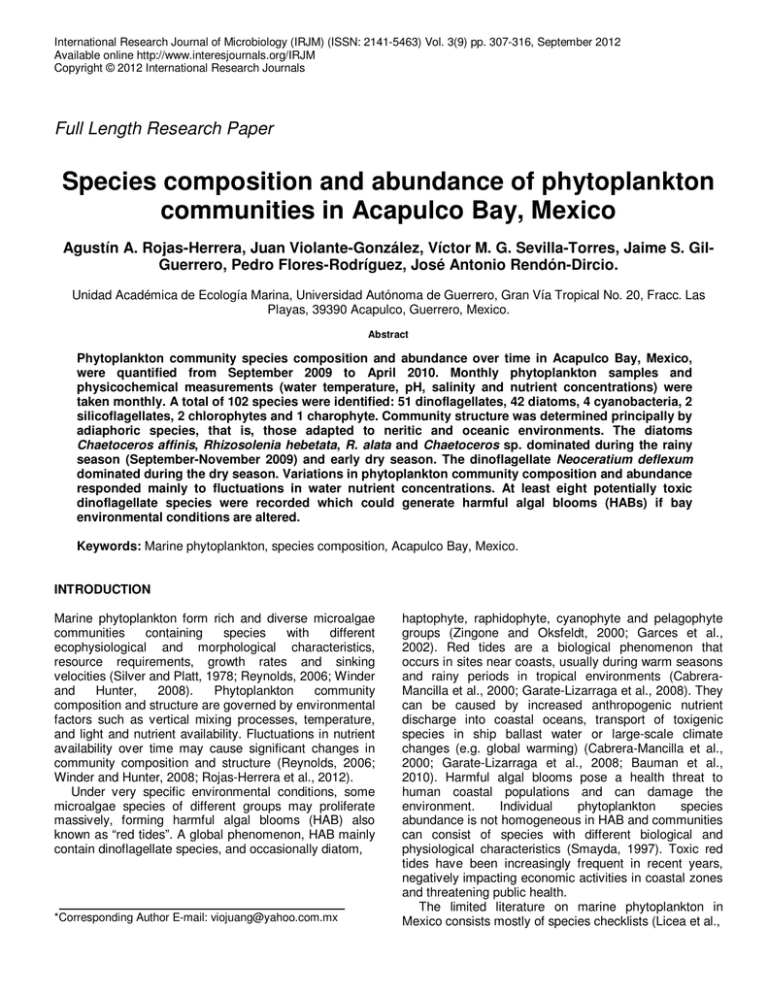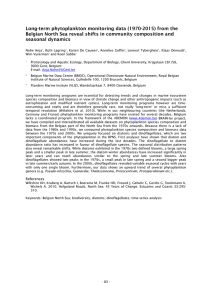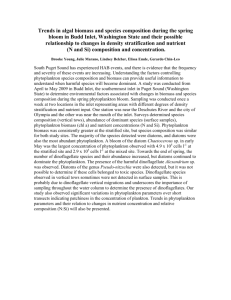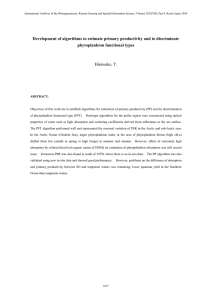Document 14111296
advertisement

International Research Journal of Microbiology (IRJM) (ISSN: 2141-5463) Vol. 3(9) pp. 307-316, September 2012 Available online http://www.interesjournals.org/IRJM Copyright © 2012 International Research Journals Full Length Research Paper Species composition and abundance of phytoplankton communities in Acapulco Bay, Mexico Agustín A. Rojas-Herrera, Juan Violante-González, Víctor M. G. Sevilla-Torres, Jaime S. GilGuerrero, Pedro Flores-Rodríguez, José Antonio Rendón-Dircio. Unidad Académica de Ecología Marina, Universidad Autónoma de Guerrero, Gran Vía Tropical No. 20, Fracc. Las Playas, 39390 Acapulco, Guerrero, Mexico. Abstract Phytoplankton community species composition and abundance over time in Acapulco Bay, Mexico, were quantified from September 2009 to April 2010. Monthly phytoplankton samples and physicochemical measurements (water temperature, pH, salinity and nutrient concentrations) were taken monthly. A total of 102 species were identified: 51 dinoflagellates, 42 diatoms, 4 cyanobacteria, 2 silicoflagellates, 2 chlorophytes and 1 charophyte. Community structure was determined principally by adiaphoric species, that is, those adapted to neritic and oceanic environments. The diatoms Chaetoceros affinis, Rhizosolenia hebetata, R. alata and Chaetoceros sp. dominated during the rainy season (September-November 2009) and early dry season. The dinoflagellate Neoceratium deflexum dominated during the dry season. Variations in phytoplankton community composition and abundance responded mainly to fluctuations in water nutrient concentrations. At least eight potentially toxic dinoflagellate species were recorded which could generate harmful algal blooms (HABs) if bay environmental conditions are altered. Keywords: Marine phytoplankton, species composition, Acapulco Bay, Mexico. INTRODUCTION Marine phytoplankton form rich and diverse microalgae communities containing species with different ecophysiological and morphological characteristics, resource requirements, growth rates and sinking velocities (Silver and Platt, 1978; Reynolds, 2006; Winder and Hunter, 2008). Phytoplankton community composition and structure are governed by environmental factors such as vertical mixing processes, temperature, and light and nutrient availability. Fluctuations in nutrient availability over time may cause significant changes in community composition and structure (Reynolds, 2006; Winder and Hunter, 2008; Rojas-Herrera et al., 2012). Under very specific environmental conditions, some microalgae species of different groups may proliferate massively, forming harmful algal blooms (HAB) also known as “red tides”. A global phenomenon, HAB mainly contain dinoflagellate species, and occasionally diatom, *Corresponding Author E-mail: viojuang@yahoo.com.mx haptophyte, raphidophyte, cyanophyte and pelagophyte groups (Zingone and Oksfeldt, 2000; Garces et al., 2002). Red tides are a biological phenomenon that occurs in sites near coasts, usually during warm seasons and rainy periods in tropical environments (CabreraMancilla et al., 2000; Garate-Lizarraga et al., 2008). They can be caused by increased anthropogenic nutrient discharge into coastal oceans, transport of toxigenic species in ship ballast water or large-scale climate changes (e.g. global warming) (Cabrera-Mancilla et al., 2000; Garate-Lizarraga et al., 2008; Bauman et al., 2010). Harmful algal blooms pose a health threat to human coastal populations and can damage the environment. Individual phytoplankton species abundance is not homogeneous in HAB and communities can consist of species with different biological and physiological characteristics (Smayda, 1997). Toxic red tides have been increasingly frequent in recent years, negatively impacting economic activities in coastal zones and threatening public health. The limited literature on marine phytoplankton in Mexico consists mostly of species checklists (Licea et al., 308 Int. Res. J. Microbiol. 1995), or focuses only species found in HAB (CabreraMancilla et al., 2000; Garate-Lizarraga et al., 2008). The only study done in Acapulco Bay to date is a quantitative analysis of the phytoplankton community (Rojas-Herrera et al., 2012). The present study aim was to increase understanding of phytoplankton composition and community structure in Acapulco Bay and how it changes over time. MATERIALS AND METHODS Phytoplankton samples were taken between September 2009 and April 2010 at five sites in Acapulco Bay: 1) Club de Yates (16°50’N, 99°54’W); 2) Islote del Morro (16°51’N, 99°53’W); 3) Naval Base (16°51’N, 99°51’W); 4) Casa de Diaz Ordaz (16°50’N, 99°51’W); and 5) Centro de la Bahia (16°49’N, 99°53’W). Samples were collected using a nylon mesh plankton net (150 µ aperture) for 5 min at water surface at each site. Water temperature (°C), pH and salinity were measured in situ with an YSI probe. Water samples (500 ml) were taken at each station to quantify nutrient (nitrates, ammonium, and phosphates) concentration following a standard colorimetric method (Hanna equip). Phytoplankton species were identified based on specialized bibliography (Round et al., 1990; Licea et al., 1995; Moreno et al., 1995). Using published phytoplankton species records for Mexico and other countries, we developed a sourcebased classification: estuarine (ES); neritic (NE); adiaphoric (AD) and oceanic (OC). We applied the Olmstead-Tukey association test (Sokal and Rohlf, 1998) to classify identified phytoplankton species based on occurrence frequency and mean abundance parameters: dominant (abundant and frequent) (D); common (low abundance but frequent) (C); occasional (abundant but low frequency) (O); and rare (low abundance and low frequency) (R). Significant differences in monthly parameters (temperature, pH and salinity) and nutrient concentrations between stations were identified with a one-way ANOVA. When significant deviations from normality were identified, parameters and concentration data were log-transformed (log x+1) to meet normality and homoscedasticity requirements. A χ2 test was applied to identify significant differences in mean phytoplankton group abundance between months. Community level parameters included total number of species (richness); total number of cells; the ShannonWiener diversity index (H); species evenness (J); and the Berger-Parker index (BPI) as a measurement of species numerical dominance (Magurran, 1991; Krebs, 1999). The qualitative Jaccard similarity index was used to evaluate similarity or difference in species composition between months. The Student’s t-test was applied to identify differences between community parameters, and correlations calculated using the Spearman range coefficient (rs) were used to identify the parameters that determined observed species distribution and composition patterns. RESULTS Mean temperature values varied significantly between months: 30.88 ± 0.44 to 24.99 ± 1.62 ºC (ANOVA, F = 208.55, P < 0.05). The lowest temperature was registered in March 2010 and the highest in September 2009 (Figure 1). Salinity also varied significantly (32.3 ± 0.48 to 35.26 ± 2.14 psu (ANOVA, F = 66.43, P < 0.05) (Figure 1), while pH values ranged from 7.78 ± 0.46 to 8.4 ± 0.2 (ANOVA, F = 17.14, P < 0.05). No significant variations in environmental parameters were recorded between sampling stations, allowing the data to be pooled in all subsequent analyses. Concentrations of the three analyzed nutrients varied significantly (P < 0.05) during the study period: nitrates (NO3 ) increased from October 2009 to January 2010; phosphate (PO4=) concentrations were higher between October and December 2009; and ammonium (NH4+) peaked in February 2010 (Figure 2). Only phosphate concentrations exhibited significant variation between stations (ANOVA, F = 3.39, P < 0.05), the highest overall concentration being recorded in December 2009 at Station 1 (Club de Yates). A total of 102 phytoplankton species were collected from Acapulco Bay: 51 dinoflagellates (Dinophyta); 42 diatoms (Bacillariophyta); 4 cyanobacteria (Cyanobacteria); 2 silicoflagellates (Heterokontophyta); 2 chlorophytes (Chlorophyta); and 1 charophyte (Charophyta) (Table 1). Diatom species numbers were relatively lower than the remaining phytoplankton species groups, but this group’s total cell abundance represented 52% of total cells collected during the sampling period. The most important Dinoflagellate genera were: Neoceratium (27 species); Protoperidinium (9); and Dinophysis (4 species). Diatom genera included Chaetoceros (11 species); Nitzchia (5); and Guinardia (4 species). Species group differentiation showed that diatoms were more abundant from September 2009 to January 2010, while dinoflagellates dominated numerically from February to April 2010 (Figure 3). Weak positive relationships were observed between nitrate concentration and dinoflagellate monthly abundance and total monthly phytoplankton cells (all groups), although these were not significant (P> 0.05). However, these same parameters registered a strong positive correlation with the ammonium concentrations (rs = 0.827, rs = 0.900, P < 0.05; respectively) Six dinoflagellate species (Neoceratium furca, N. fusus, N. ibidem, N. macroceros, N. trichoceros, and N. tripos), 6 diatom species (Chaetoceros affinis, Ch. curvisetus, Ch. didymus, Chaetoceros sp., Coscinodiscus Rojas-Herrera et al. 309 36 Temperature Temperature oC 30 35 Salinity 28 34 26 33 24 32 22 31 20 Salinity (psu) 32 30 Sep-09 Oct Nov Dec Jan-10 Feb Mar Apr Figure 1. Monthly temperature and salinity values in Acapulco Bay, Mex. (September 2009- April 2010 period) 1.60 Nit rates Phosphates Ammonium 1.40 (mg/L) 1.20 1.00 0.80 0.60 0.40 0.20 0.00 Sep-09 Oct Nov Dec Jan-10 Feb Mar Apr Figure 2. Monthly nutrient concentrations (mg/L) in Acapulco Bay, Mex. heteroporus, and Rhizosolenia hebetate), as well as the cyanobacteria Phormidium limosum occurred in all months (Table 1). Five species numerically dominated the sampled phytoplankton communities: 1 dinoflagellate (Neoceratium deflexum) and 4 diatoms (Chaetoceros sp., Ch. affinis, Rhizosolenia hebetate, and R. alata (Table 2). These species represented 25% of total estimated cell counts in all samples. Phytoplankton species distribution analysis showed over 60% of the dinoflagellate and diatom species to be adiaphoric species (i.e. occurring in neritic and oceanic areas; Figure 4). Frequency-abundance graphics indicated 36% of the microalgae species to be dominant (i.e. abundant and frequent) and 50% to be rare. No differences (P>0.05) in phytoplankton abundance (cell/L) were observed between the 5 sampled stations. Species richness varied significantly (t–test = 11.11, P < 0.05) from 26 species (November 2009) to 55 (February and March 2010), while monthly total abundance ranged from 1695 cells (November 2009) to 8196 cells (February 2010). The monthly diatom cell counts were higher than other phytoplankton groups from September 2009 to January 2010, while dinoflagellate cell counts were higher from February to April 2010 (Table 2). Shannon-Wiener diversity index values were ≥ 3 bits/ind. in all months, and they differed between months (t-test = 29.35, P< 0.05). Evenness ranged from 0.60 to 0.75, and also differed between months (t-test = 310 Int. Res. J. Microbiol. Table 1. Abundance of phytoplankton species (cell/L) in Acapulco Bay, Mexico. Distribution: 1 = Estuarine, 2 = Neritic, 3 = Adiaphoric, 4 = Oceanic. Classification: (D) dominant, (C) common, (O) occasional), (R) rare. Species Dinophyta 3 (R) Amphisolenia bidentata Amphisolenia lemmermanni 3 (R) Amphisolenia sp.(R) 3 (R) Ceratocorys horrida 3 (D) Dinophysis caudata Dinophysis rotundata 3 (R) Dinophysis tripos 3 (R) 3 (R) Dinophysis sp. 2 (R) Gonyaulax poliedra Gonyualax polygramma 3 (R) Gonyaulax sp. (D) Neoceratium arietinum 3 (R) Neoceratium candelabrum 3 (D) Neoceratium carriense 3 (D) Neoceratium concilians 3 (R) 3 (R) Neoceratium contortum Neoceratium contrarium 3 (R) Neoceratium deflexum 3 (D) Neoceratium dens 3(D) Neoceratium extensum 2(R) Neoceratium furca 2 (D) Neoceratium fusus 2 (D) Neoceratium ibidems 3 (D) Neoceratium incisum 3 (R) Neoceratium inflatum 3 (D) Neoceratium kofoidii 3(R) Neoceratium lineatum 3(R) Neoceratium longirostrum 3 (D) Neoceratium lunula 3 (D) Neoceratium macroceros 3 (D) Neoceratium massiliense 4 (O) Neoceratium pentagonum 3 (R) Neoceratium ranipes 4 (R) Sep. 09 Oct. Nov. Dec. Jan. 10 Feb. Mar. Apr. 2 1 2 4 2 1 1 1 11 112 1 97 53 100 110 64 7 13 47 59 72 2 1 1 2453 6 4 146 308 519 666 1 1214 251 62 43 249 4 6 6 1 6 17 7 166 67 141 1 1 6 3 5 1 3 11 36 2 1 3 8 100 25 178 1 86 43 391 14 123 61 11 79 18 4 19 55 37 34 39 101 1 1 1 1 171 24 24 1 44 15 12 3 6 5 17 90 57 72 5 1 3 3 3 6 23 8 4 Rojas-Herrera et al. 311 Table 1 continue Neoceratium symetricum 4 (R) Neoceratium trichoceros 3 (D) Neoceratium tripos 3 (D) 3 (D) Neoceratium vultur (D) Neoceratium sp. Ornithocercus steinii 3 (D) (R) Ornithocercus sp. 2 (D) Prorocentrum gracile Protoperidinium cerasus 3 (R) Protoperidinium claudicans 3 (D) 3 (R) Protoperidinium conicum Protoperidinium diabolum 3 (R) Protoperidinium divergens 3 (D) Protoperidinium exentricum 3 (R) Protoperidinium pellucidum 3 (R) 3 (R) Protoperidinium pentagonum (D) Protoperidinium sp. 4 (D) Pyrocystis fusiformis Subtotal Bacillariophyta Amphiprora gigantea 3 (R) Asterionella japonica 3 (R) Bacteriastrum delicatulum 4 (R) Chaetoceros affinis 3 (D) Chaetoceros constrictus 3 (O) Chaetoceros curvisetus 3 (D) Chaetoceros decipiens 3 (D) Chaetoceros debilis 3 (R) 3 (D) Chaetoceros didymus Chaetoceros lorenzianus 2 (D) Chaetoceros socialis 2 (D) Chaetoceros teres 3 (D) Chaetoceros tetrastichon 4 (R) Chaetoceros sp. (D) Coscinodicus heteroporus 3 (D) 1 82 1 461 40 141 4 95 90 70 135 1 87 233 2 1 1 2 1 1 1 1 1 295 1056 1 2 1 1 5 1 1 1 401 432 1040 17 825 992 17 10 2 1 3 1 11 1 79 122 218 1 1 305 7 5 34 12 2 14 3 468 176 2737 5844 21 187 599 12 12 2 53 1 155 200 3404 2 1 433 57 43 51 16 400 38 8 311 21 22 110 35 46 4 22 1 229 41 24 20 47 25 1 21 14 1 5 136 4 76 233 4 1 101 2 24 52 75 485 32 82 5 1 91 11 3 4 6 888 50 1131 19 1319 59 1001 236 766 173 224 94 145 50 69 312 Int. Res. J. Microbiol. Table 1 continue Coscinodiscus sp. (R) Ditylum brightwelli 3 (D) 2 (D) Guinardia delicatula 3 (R) Guinardia flaccida Guinardia striata 3 (D) (R) Guinardia sp. 3 (R) Gyrosigma peisonis 2 (D) Hemiaulus sinensis Leptocylindrus danicus 3 (D) 2 (R) Licmophora abbreviata 3 (R) Nitzschia closterium Nitzschia delicatisima3 (C) Nitzschia pacifica 3 (D) Nitzschia paradoxa 1 (R) Nitzschia sigma (1 (R) Nitzschia seriata (1 (R) Nitzschia sp. (D) Pleurosigma normanii 3 (R) Pleurosigma sp. (R) 3 (D) Pseudonitzschia delicatissima 3 (R) Pseudonitzschia seriata Planktoniella sol 4 (D) Rabdonema sp. (D) Rhizosolenia alata 3 (D) Rhizosolenia hebetata 3 (D) Rhizosolenia setigera 2 (R) Skeletonema costatum 3 (D) Stephanopyxis palmeriana 3 (D) Thalassionema frauenfeldii 4(R) Subtotal Heterokontophyta Dictyocha fibula 4 (R) 4 (R) Dictyocha octonaria Subtotal Chlorophyta Chlamydomonas sp. (R) 8 28 1 44 38 4 11 21 11 65 1 20 6 1 20 14 25 25 6 26 67 10 3 24 61 1 39 1 29 136 1 140 1 6 11 115 228 23 13 18 1 18 2 14 10 2 1 8 59 1 1 2 308 378 5 5 2600 255 509 509 418 49 947 7 3 6 82 1547 1255 3 2612 9 9 1 2 14 160 3 10 48 14 110 1 1788 2307 14 180 23 759 2 1 1 1 6 119 1 924 2486 2402 1 2 1 1 Rojas-Herrera et al. 313 Table 1 continue Volvox sp. (R) Subtotal Charophyta Staurastrum sp(R) Subtotal Cyanobacteria 1 (R) Microcystis aeruginosa 1 (D) Phormidium limosum Spirulina sp. (O) (R) Trichodesmium sp. Subtotal 1 1 1 10 10 4 4 Total abundance 4 4 2 2 1 1 4 3 8 35 9 193 34 171 34 71 4 2 13 35 9 193 34 171 105 2899 2625 1695 3054 3022 8196 5397 5918 Table 2. Characteristics of the phytoplankton community in Acapulco Bay, Mexico. Dino = dinoflagellates, Diat = diatoms; BPI = Berger-Parker Index; H = Shannon-Wiener diversity index; J = evenness. Month No. of species Sep. 09 Oct. Nov. Dec. Jan. 10 Feb. Mar. Apr. 39 31 26 43 42 55 55 53 Dino. No. cell 295 1056 401 432 1040 5844 2737 3404 32.8, P< 0.05). Species composition similarity ranged from 15 to 66% (mean = 38.6% ±14.2) during the sampling period, with the highest values in March and April 2010 (Figure 5). Diat. No. cell 2600 1547 1255 2612 1788 2307 2486 2402 Total cell Dominant specie BPI H´ J´ 2899 2625 1695 3054 3022 8196 5397 5918 Chaetoceros affinis Rhizosolenia hebetata Rhizosolenia alata Rhizosolenia hebetata Chaetoceros sp. Neoceratium deflexum Chaetoceros sp. Neoceratium deflexum 0.15 0.19 0.33 0.31 0.37 0.30 0.19 0.21 3.81 3.70 3.07 3.24 3.46 3.42 3.93 4.06 0.72 0.75 0.65 0.60 0.64 0.59 0.68 0.71 DISCUSSION Water temperature decreased steadily from September 2009 to January 2010 (Figure 1), whereas salinity dropped significantly only in October 2009. Temperature fluctuations in tropical marine areas are not as marked as in temperate or cold latitudes; suggesting that this parameter 314 Int. Res. J. Microbiol. Total abundance (cell/L) 7000 6000 Dinoflagellates Diatoms 5000 4000 3000 2000 1000 0 Sep-09 Oct Nov Dec Jan-10 Feb Mar Apr Figure 3. Temporal variation of total relative abundance (%) of Phytoplankton groups in Acapulco Bay, Mex. 90 80 Frec. ( % ) 70 Dinophyta Bacillariophyta 60 50 40 30 20 10 0 ES NE AD OC Figure 4. Frequence distribution of phytoplankton species in Acapulco Bay, based on its origin. ES: Estuarine, NE: Neritic, AD: Adiaforical, OC: Oceanic does not have an important effect on species composition in tropical phytoplankton communities (Varona-Cordero and Gutierrez-Mendieta, 2006). In contrast, salinity is known to have a notable effect on phytoplankton community structure, particularly in estuarine and coastal environments (Peña and Pinilla, 2002; Lassen et al., 2004; Troccoli et al., 2004). The observed decrease in salinity in October (Figure 1) can be attributed to freshwater flow into the bay during the rainy season (June to November). The constant increase in nitrate and phosphate concentrations from October 2009 to January 2010 may also be attributed to rainfall runoff during the rainy season (Moreira et al., 2007). Sewage, as well as substantial amounts of garbage and other solid materials from the Acapulco urban area discharge directly into the bay, contributing to higher nutrient concentrations and consequently rapid population growth in several phytoplankton species (Varona-Cordero and GutierrezMendieta, 2006; Moreira et al., 2007). Dinoflagellates (51 species) dominated the Acapulco Bay phytoplankton community in terms of species richness (Table 1), although total dinoflagellate abundance was similar to that of diatoms (Table 2). This contrasts with the numerical dominance of diatoms in species number reported in other phytoplankton composition studies done at tropical latitudes (Peña and Pinilla, 2002; Ochoa and Tarazona, 2003; VaronaCordero and Gutierrez-Mendieta, 2006; Moreira et al., 2007). However, our results coincide with a previous study from the same area (Rojas-Herrera et al., 2012). Phytoplankton species groups are considered good Rojas-Herrera et al. 315 Figure 5. Similarity percentages for monthly phytoplankton samples in Acapulco Bay, Mexico. indicators within marine environment water masses (Castillo and Vidal, 1982). Dinoflagellates are better adapted to the oceanic environment, while diatoms are more adapted to coastal environments (Castillo, 1984; Peña and Pinilla, 2002). The presence of variation in the monthly cell abundances of these two important microalgae groups throughout the year (Figure 3), suggests that environmental conditions in Acapulco Bay change during the year in response to variations in several physicochemical parameters. Changes in the bay’s water masses are probably reflected in the changing nature of its phytoplankton community; for example, more than 60% of the dinoflagellate and diatom species recorded in the present study are adiaphoric (adapted to neritic or oceanic environments) (Peña and Pinilla, 2002) (Figure 4). Different species dominated numerically in each month, indicating wide variability in species composition over time. The diatoms Chaetoceros affinis, Rhizosolenia hebetata, R. alata, and Chaetoceros sp. dominated during the rainy season (September-November 2009), and early dry season (Table 2). While the dinoflagellate Neoceratium deflexum dominated during the dry season. Some studies indicate that changes in phytoplankton community structure can be associated with small changes in water temperature (Varona-Cordero and Gutierrez-Mendieta, 2006; Ochoa and Tarazona, 2003) or with the different strategies used by phytoplankton groups to absorb available nutrients in the water column (Langlois and Smith, 2001). The decrease in water temperature from September 2009 to January 2010 may have affected dinoflagellate abundance during this period since this microalgae group is highly sensitive to minor drops in water temperature (Varona-Cordero and Gutierrez-Mendieta, 2006; Ochoa and Tarazona, 2003; Moreira et al., 2007). Diatoms, in contrast, are less sensitive to slight shifts in water temperature and can respond more rapidly to increases in available nutrient concentrations (Örnólfsdóttir et al., 2004), as occurred at the end of the rainy season (Figure 3). The higher monthly diatom abundance in the late rainy season (December 2009) can be attributed to a higher abundance of Rhizosolenia hebetata (Tables 1 and 2), a large diatom (Moreira et al., 2007) that represented 36% of total cells in this microalgae group for this month. In contrast, Neoceratium deflexum was largely responsible for the notable increase in dinoflagellate abundance in February 2010 (Tables 1 and 2); indeed, this high abundance was probably caused almost entirely by Neoceratium genus dinoflagellates. Under the proper environmental conditions, these can form long multi-cell chains and accumulate in large populations (VargasMontero et al. 2008). The strong influence of the rainy and dry seasons on phytoplankton composition and abundance in Acapulco Bay coincides with many other studies done in tropical regions (Moreira et al., 2007). Of the 51 dinoflagellate species identified here, at least eight (Dinophysis caudata, D. rotundata, D. tripos, Gonyaulax polygramma, G. spinifera, Neoceratium furca, N. fusus and N. tripos) have been linked to harmful algal blooms (HABs) in other locations in Mexico (CortesAltamirano, 1998). In the present case, however, only the dinoflagellates Neoceratium furca, N. fusus and N. tripos 316 Int. Res. J. Microbiol. were frequent, although they did not numerically dominate any of the samples (Table 1). The phytoplankton community species distribution pattern in Acapulco Bay was similar to that reported for other marine or estuarine communities. Community structure was determined by a low number of dominant species (36%), which contributed over 90% of total abundance, as well as a high number of occasional and rare species (62%). Total richness (102 species) and diversity values (3.07 to 4.06 bits/ind) registered in the study area were within ranges previously reported in the same area (RojasHerrera et al., 2012), as well as for other areas of Mexico (Varona-Cordero and Gutierrez-Mendieta, 2006) and other countries with similar climate conditions (Peña and Pinilla, 2002; Ochoa and Tarazona, 2003; Moreira et al., 2007). The low similarity values observed here (mean = 39%) suggest that species composition differed between months in response to variability in environmental conditions over time. Overall, the results indicate that phytoplankton composition and species abundance in Acapulco Bay varied temporally in response to fluctuations in environmental conditions. Primary among these fluctuations were the different levels of water nutrient concentrations caused by differing rainfall discharge levels into the bay during the rainy season (June to November). Higher nutrient concentrations and slight variations in water temperature promoted population growth in some dinoflagellate or diatom species at different times during the year. ACKNOWLEDGEMENTS The research reported here was partially financed by the Conacyt and the State of Guerrero through the project “Estudio ecológico de la Bahía de Acapulco” (FOMIX 2008-01). It was also partially financed through the projects: “Diversidad de peces de sustrato rocoso, en la bahía de Acapulco, Gro”. and “Parásitos de rayas de importancia económica y ecológica en la Bahía de Acapulco, Guerrero, Mex.” REFERENCES Bauman AG, Burt JA, Feary DA, Marquis E, Usseglio P (2010). Tropical harmful algal blooms: an emerging threat to coral reef communities?. Mar. Pollut. Bull. 60: 2117−22. Cabrera-Mancilla E, Ramírez-Camarena C, Muñoz-Cabrera L, MonrealPrado A (2000). Primer registro de Gymnodinium catenatum Graham (Gymnodiniaceae) como causante de marea roja en la Bahía de Acapulco, Gro. México. In: Ríos-Jara, E., E. Juárez-Carillo, M. PérezPeña, E. López-Uriarte, E. G. Robles-Jarero, D. U. HernándezBecerril, M. Silva-Briano (eds.). Estudios sobre plancton en México y el Caribe. Sociedad Mexicana de Planctonología y Universidad de Guadalajara. p. 85−86. Castillo F (1984). Fitoplancton del Pacífico colombiano como indicador de masas de agua. Erfen IV. Biol. Pesq. 13: 67−70. Castillo F, Vidal A (1982). Fitoplancton del Pacífico colombiano como indicadores de masas de agua. Fase CIOH, Cartagena. p. 1−57. Cortés-Altamirano R (1998). Informe regional sobre mareas rojas en México. IOCARIBE-ANCA. II Taller regional, Ciudad de la Habana, Cuba. 4 p. Gárate-Lizárraga I, Pérez-Cruz B, Díaz-Ortíz J, Band-Schmidt CJ (2008). Microalgas y biotoxinas marinas en las costas mexicanas. Conver. 9: 22−26. Garcés E, Zingone A, Montresor M, Reguera B, Dale B (2002). Lifehab: Life histories of microalgal species causing harmful blooms. (eds.). Office for the Official Publications of the European Communities, Luxemburgo. 220 p. Krebs CJ (1999). Ecological methodology. Addison-Welsey Educational Publishers, Inc. Boston, Massachusetts 654 p. Langlois GW, Smith P (2001). Phytoplankton In: Biology and Ecological Niches in the Gulf of the Farallones: U.S. Geological Survey, Reston, Virginia. p. 32−35. Lassen MF, Bramm ME, Richardson K, Youssof F, Shariff M (2004). Estuaries. 27: 716−727. Licea S, Moreno JL, Santoyo H, Figueroa G (1995). Dinoflagelados del Golfo de California. México. Universidad Autónoma de Baja California Sur, México 165 p. Magurran A (1991). Ecological diversity and its measurement. Princeton University Press, Princeton, New Jersey, 178 p. Moreno JL, Licea S, Santoyo H (1995). Diatomeas del Golfo de California. México. Universidad Autónoma de Baja California Sur, México 273 p. Moreira A, Seisdedo M, Leal S, Comas A, Delgado G, Regadera R, Alonso C, Muñoz A, Abatte M (2007). Composición y abundancia del fitoplancton de la Bahía de Cienfuegos, Cuba. Rev. Invest. Mar. 28:97−109. Ochoa N, Tarazona J (2003). Variabilidad temporal de pequeña escala en el fitoplancton de Bahía Independencia, Pisco, Perú. Rev. Peru. Biol. 10: 59−66. Örnólfsdóttir EB, Lumsden E, Pinckney JL (2004). Phytoplankton community growth-rate response to nutrient pulses in a shallow turbid estuary, Galveston Bay, Texas. J. Plank. Res. 26: 325−339. Peña V, Pinilla GA (2002). Composición, distribución y abundancia de la comunidad fitoplanctónica de la ensenada de Utría, Pacífico colombiano. Rev. Biol. Mar. Oceanogr. 37: 67−81. Reynolds CS (2006). Ecology of phytoplankton. Cambridge University Press. Rojas-Herrera AA, Violante-González J, García-Ibáñez S, SevillaTorres VMG, Gil-Guerrero JS, Flores-Rodríguez P (2012). Temporal variation in the phytoplankton community of Acapulco Bay, Mexico. Microbiol. Res. 13-19. Round FE, Crawford RM, Mann DG (1990). The Diatoms. Biology and morphology of the genera. Cambridge. University Press. 747 p. Silver W, Platt T (1978). Energy flux in the pelagic ecosystem: A timedependent equation. Limnol. Oceanograp. 23: 813−816. Smayda TJ (1997). Harmful algal blooms: Their ecophysiology and general relevance to phytoplankton blooms in the sea. Limnol. Oceanogr. 5: 1137-1153. Sokal RR, Rohlf FJ (1998). Biometry, 2nd ed. W. H. Freeman and Company, San Francisco, California, 859 p. Troccoli LG, Herrera-Siveira JA, Comín F (2004). Structural variations of phytoplakton in the coastal seas of Yucatán, México. Hidrobiol. 519: 85−102. Vargas-Montero M, Bustamante EF, Guzmán JC, Vargas JC (2008). Florecimientos de dinoflagelados nocivos en la costa Pacífica de Costa Rica. Hidrobiol. 18: 15−23. Varona-Cordero F, Gutiérrez-Mendieta FJ (2006). Composición estacional del fitoplancton de dos lagunas del Pacífico tropical. Hidrobiol. 16: 159−174. Winder M, Hunter DA (2008). Temporal organization of phytoplankton communities linked to physical forcing. Oecol. 156: 179−192. Zingone A, Oksfeldt EH (2000). The diversity of harmful algal blooms: A challenge for science and management. Ocean. Coast. Manag. 43: 725−748.








